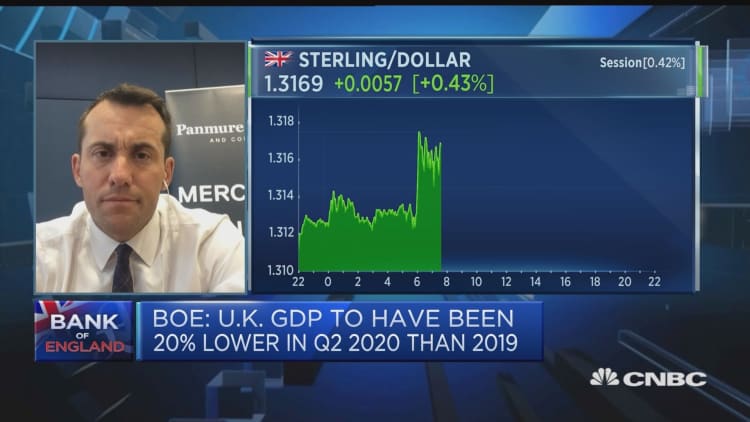The Bank of England on Thursday held interest rates steady and maintained its existing level of asset purchases, but warned it is anticipating a slower economic recovery from the coronavirus crisis.
All members of the Monetary Policy Committee voted to keep the main lending rate at 0.1%, with the central bank having cut rates twice from 0.75% since the beginning of the pandemic.
The committee also voted unanimously against extending its bond-buying program, having announced an additional £100 billion ($131.4 billion) expansion in June which took the total value of the Asset Purchase Facility to £745 billion.
However, the central bank said it does not expect the U.K. economy to exceed its pre-coronavirus levels until the end of 2021. It had previously projected that GDP (gross domestic product) may return to 2019 fourth-quarter size in the second half of next year.
In the shorter-term, policymakers gave a more optimistic outlook, with GDP now expected to shrink by 9.5% in 2020 compared to the 14% contraction expected in May. It is then expected to rebound by 9% in 2021 and grow by a further 3.5% in 2022.

The BOE said the U.K.'s economic recovery will "depend critically on the evolution of the pandemic, measures taken to protect public health, and how governments, households and businesses respond to these factors."
It reiterated that it will continue to monitor the situation and stands ready to adjust monetary policy accordingly.
The central bank will also be waiting to gauge the extent of an anticipated surge in unemployment in the fall. The U.K. is set to end its furlough scheme in October, which has partially subsidized wages for millions of furloughed workers during the pandemic.
Economists have suggested that many of these workers are unlikely to be reabsorbed into the jobs market. In its August monetary policy report, the BOE said the unemployment rate was projected to rise to around 7.5% by the end of 2020, down from a previous forecast of just below 10%, before gradually recovering.
Inflation was 0.6% in June, up from 0.5% in May, but well below the Bank's 2% target, and is expected to fall further to average around 0.25% in the latter part of the year to reflect the impacts of Covid-19.
Hugh Gimber, global market strategist at JPMorgan Asset Management, said that despite data so far exceeding the Bank's prior expectations, Thursday's report still presents a "sobering assessment" of the downside risks.
"While more optimistic than the scenario published earlier this year, expectations for a sharp rise in unemployment later by Q4 are still stark. The Bank has used a vast range of policy tools in 2020 to support the U.K. economy, but it seems that there is little more that the central bank can do to prevent such an outcome," Gimber said, adding that pressure will instead fall on the government to reconsider its winding down of the furlough scheme.
"Today the Bank has added to the growing number of voices highlighting the dangers of removing labor market support before the worst-hit industries are able to re-absorb jobs that have been put on hold during the pandemic," he added.
Like many of Europe's major economies, the British government has been forced to reintroduce some restrictions on travel and social activity in recent weeks amid fears of a second surge in coronavirus cases, while a new localized lockdown has been announced in the Scottish city of Aberdeen.
Alongside the pandemic, the U.K. is also navigating tense discussions with EU leaders in a bid to hammer out a new trading relationship. Should talks fail, the U.K. would face a sudden exit from its transitional period without a trade agreement at the end of the year, a scenario widely expected to compound the economic damage caused by the pandemic. The next round of talks is set to commence on August 17.

